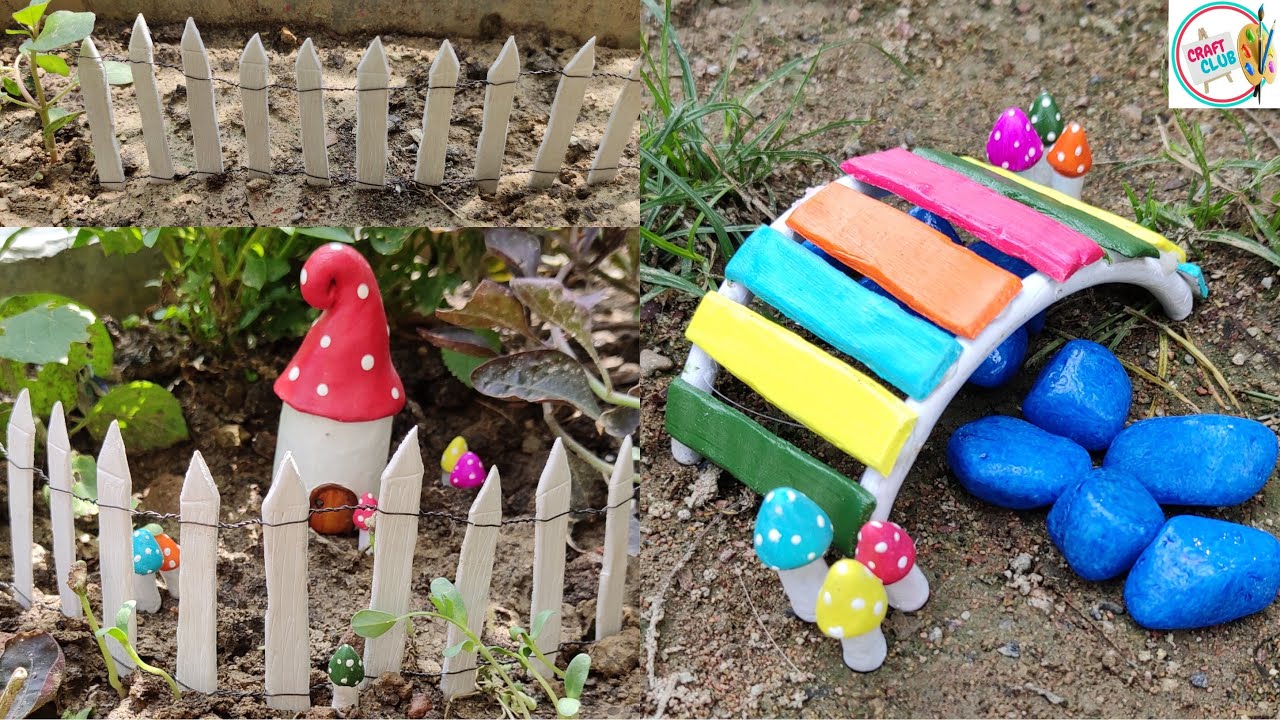Have you ever thought about creating a fairy garden in your backyard? It’s such a magical and whimsical way to liven up your outdoor space. And one of the key elements in creating a beautiful fairy garden is a fence. But where do you even start? Don’t worry, in this article, we’re going to dive into the world of creating a fairy garden with a fence and give you all the tips and tricks you need to know.
When it comes to creating a fairy garden, the possibilities are endless. You can let your imagination run wild and create a miniature world filled with tiny houses, colorful flowers, and of course, a charming little fence. In this article, we’ll explore the different types of fences you can use, from rustic wooden fences to delicate wrought iron ones. We’ll also guide you through the process of designing your fairy garden, from choosing the perfect location to selecting the right plants to complement your fence. So get ready to turn your backyard into a fairy wonderland – this article is going to be your ultimate guide!

Creating a Fairy Garden with a Fence
Are you looking to add a touch of magic to your garden? Creating a fairy garden with a fence is a delightful way to invite whimsy and enchantment into your outdoor space. Not only does it provide a charming display, but it also offers numerous benefits. In this article, we will explore the many advantages of having a fairy garden with a fence, as well as guide you through the process of selecting the perfect location, choosing the right fence, preparing the ground, creating a design plan, selecting plants, adding fairy accessories, maintaining the garden, dealing with common challenges, and even attracting wildlife. So let your imagination take flight as we embark on this magical journey.
Benefits of Having a Fairy Garden with a Fence
- Enhances the aesthetic appeal: A fairy garden with a fence adds an enchanting and whimsical touch to your outdoor space. It acts as a focal point, attracting attention and sparking curiosity among visitors.
- Provides a sense of enclosure: The presence of a fence creates a boundary that separates the fairy garden from the rest of your garden, giving it a cozy and intimate feel.
- Offers protection: The fence acts as a physical barrier, preventing pets, children, or other animals from accidentally damaging your fairy garden. It helps preserve the delicate plants, accessories, and structures within the designated area.
- Defines the space: A fence clearly demarcates the boundaries of your fairy garden, keeping it organized and separate from the rest of your garden or landscape. It creates a designated area where you can let your creativity flourish.
- Provides a backdrop for fairy accessories: The fence serves as a backdrop, allowing your fairy accessories and plants to stand out and create a captivating display. It adds depth and dimension to the overall design.
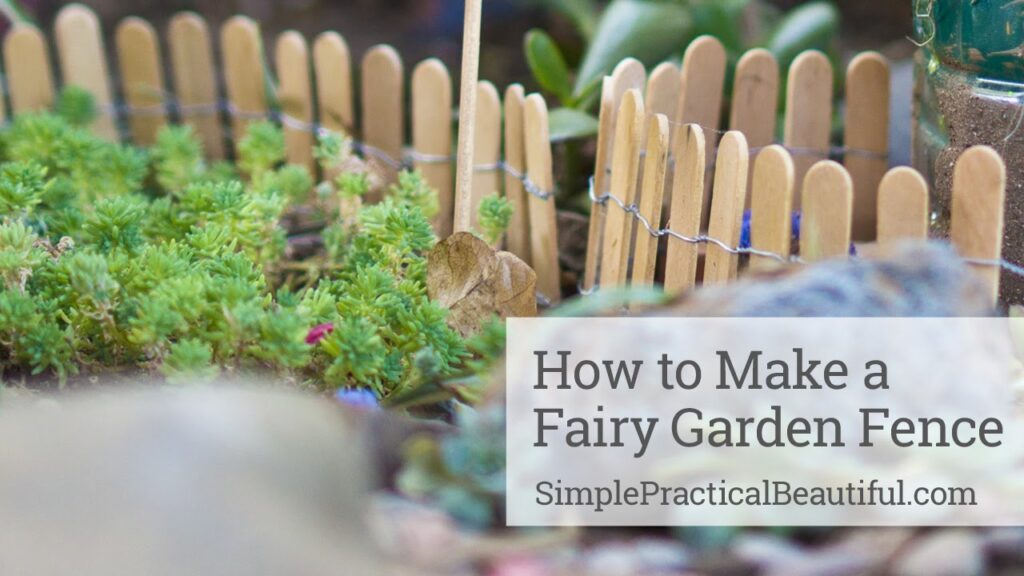
Selecting the Perfect Location for Your Fairy Garden
Before you start creating your fairy garden, it is crucial to choose the perfect location. Here are some factors to consider:
- Sunlight exposure: Most fairy garden plants thrive in areas with partial shade or filtered sunlight. Choose a location that provides the right amount of light for your plants to flourish.
- Accessibility: Ensure that the location is easily accessible for maintenance tasks such as watering, pruning, and cleaning. You don’t want to struggle with reaching your fairy garden once it is fully established.
- Visibility: Select a spot where your fairy garden will be visible and easily enjoyed. It could be near a patio, seating area, or pathway where you and your guests can admire the magical display.
- Proximity to water source: Consider the proximity of your fairy garden to a water source for easy watering and irrigation. This will help ensure your plants receive the moisture they need to thrive.
- Protection from strong winds: If your garden is exposed to strong winds, it is advisable to choose a location that offers some natural protection, such as a nearby wall or shrubs.
Choosing the Right Fence for Your Fairy Garden
The type of fence you choose for your fairy garden will significantly impact its overall aesthetic appeal. Here are some stunning options:
- White picket fence: A classic and timeless option, the white picket fence adds a charming and traditional look to your fairy garden. It creates a sense of nostalgia and perfectly complements a cottage or English garden theme.
- Rustic wooden fence: If you prefer a more natural and rustic appearance, a wooden fence is an excellent choice. It blends seamlessly with the surrounding environment and gives your fairy garden a warm and inviting feel.
- Decorative metal fence: For a touch of elegance and sophistication, consider a decorative metal fence. Intricate designs and patterns add a visual appeal, enhancing the magical atmosphere of your fairy garden.
- Vinyl fence: If durability and low maintenance are a priority, a vinyl fence is an ideal option. It comes in various styles and colors, providing versatility and customization options for your fairy garden.
Consider the style, size, and material of the fence that best suits your preferences and complements the overall theme of your fairy garden.
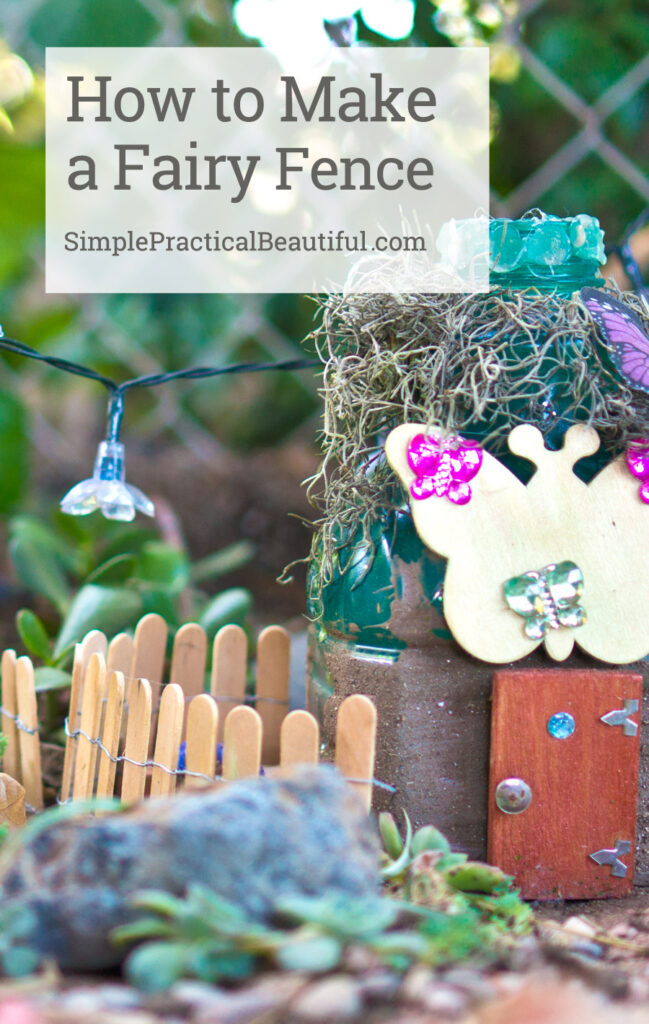
Preparing the Ground for Your Fairy Garden
Once you have identified the perfect location and selected your fence, it’s time to prepare the ground for your fairy garden. Follow these steps for a successful setup:
- Clear the area: Remove any existing plants, debris, or objects from the designated fairy garden area. Ensure the ground is clear and ready for your creative vision.
- Level the ground: Using a rake or shovel, level the ground to create a smooth and even surface for your fairy garden. This will help with both aesthetics and practicality.
- Add soil and compost: Enhance the quality of the soil in your fairy garden by adding a layer of nutrient-rich soil and compost. This will provide a fertile environment for your plants to thrive.
- Consider drainage: Fairy gardens require proper drainage to prevent waterlogged soil. If your chosen location has poor drainage, consider adding a layer of gravel or incorporating raised beds to promote better water flow.
Once you have prepared the ground, it’s time to unleash your creativity and bring your fairy garden design plan to life.
Creating a Design Plan for Your Fairy Garden
Before you start planting and adding accessories, it’s essential to have a design plan in place. Consider the following elements when creating your fairy garden design:
- Theme and style: Decide on a theme or style that captures your imagination. It could be a whimsical woodland theme, a mystical fairy village, or a serene flower garden. Let your personal taste and creativity guide you.
- Focal point: Choose a focal point within your fairy garden to draw attention and create visual interest. This could be a fairy house, a miniature pond, or a beautifully crafted fairy statue.
- Pathways and stepping stones: Create pathways or use stepping stones to guide visitors through your fairy garden. This adds an element of adventure and allows for exploration within the enchanted space.
- Varied heights and levels: Incorporate plants and accessories of varying heights and levels to add drama and depth to your fairy garden. This can be achieved through hanging baskets, tiered planters, or elevated platforms.
- Color palette: Consider the color palette you want for your fairy garden. Harmonious colors or contrasting hues can create different moods and evoke specific emotions.
- Balance and proportion: Strive for balance and proportion in your design. Place taller plants at the back and shorter ones at the front to create depth and ensure that no element overwhelms the others.
By sketching out your design plan, you can visualize how the different elements will come together and make any necessary adjustments before implementation.
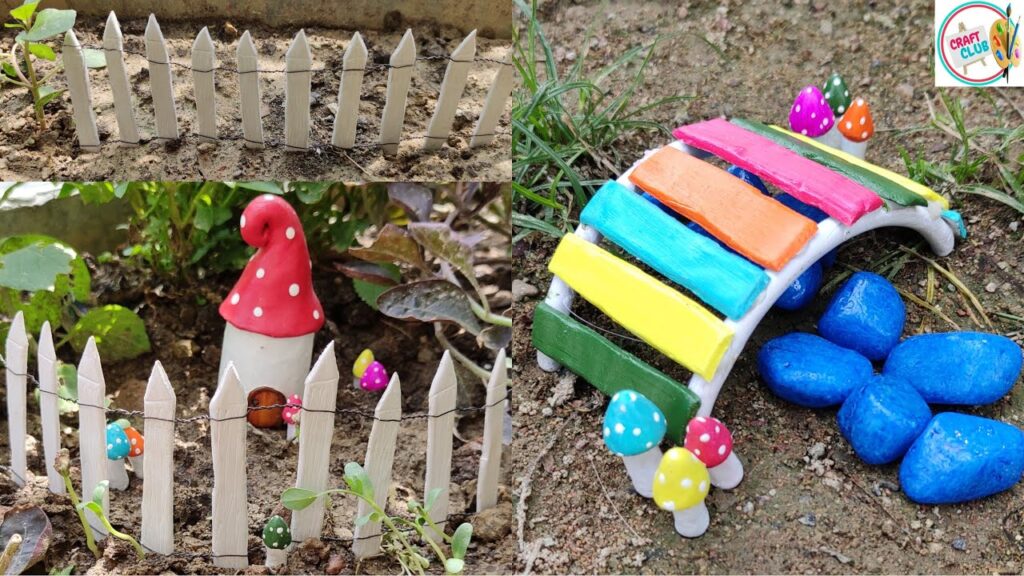
Types of Plants for Your Fairy Garden
The right selection of plants is vital for the success of your fairy garden. Here are some types of plants that you can incorporate:
Flowering Plants for a Fairy Garden
- Miniature roses: These delicate blooms add a touch of elegance and fragrance to your fairy garden. Choose compact varieties that are suitable for small spaces.
- English lavender: Known for its heavenly scent and beautiful purple flowers, English lavender brings a calming and serene atmosphere to your fairy garden.
- Violas: These dainty flowers come in a range of colors and are perfect for creating a whimsical and colorful display. They are easy to grow and maintain.
- Sedums: With their fleshy leaves and low-growing habit, sedums add texture and interest to your fairy garden. They come in various colors and require minimal care.
Evergreen Plants for a Fairy Garden
- Irish moss: A low-growing ground cover, Irish moss forms dense mats of emerald green foliage. It provides a lush and carpet-like appearance, perfect for creating an enchanting pathway in your fairy garden.
- Dwarf conifers: These miniature versions of conifer trees add an element of height and structure to your fairy garden. Their evergreen foliage ensures your garden remains delightful all year round.
- Boxwood: Boxwood shrubs are known for their neat and compact growth habit. They can be easily pruned into various shapes, making them ideal for creating hedges or topiaries in your fairy garden.
Ground Cover Plants for a Fairy Garden
- Creeping thyme: This fragrant herb spreads low and wide, forming a dense ground cover. Its delicate flowers add a pop of color, and its scent attracts pollinators, such as bees and butterflies.
- Corsican mint: With its delightful minty aroma and compact growth habit, Corsican mint is a perfect choice for ground cover in your fairy garden. It fills the air with a refreshing fragrance when stepped on.
- Moss: The velvety texture of moss adds a lush and magical touch to your fairy garden. It thrives in shaded areas and requires minimal care, making it an excellent choice for ground cover.
Choose a mix of flowering plants, evergreens, and ground cover plants to create a diverse and visually appealing fairy garden. Consider the growing conditions, such as sunlight exposure and soil requirements, when selecting your plants.
Adding Fairy Accessories to Your Fairy Garden
Now that your plants are in place, it’s time to add the finishing touches with fairy accessories. These accessories bring your fairy garden to life and create a whimsical and enchanting atmosphere. Here are some popular fairy accessories to consider:
Fairy Figurines and Statues
- Fairy figurines: Choose miniature fairy figurines in various poses and styles to populate your fairy garden. These tiny creatures add a sense of magic and wonder, creating a realistic fairy village.
- Fairy houses: No fairy garden is complete without a fairy house. Opt for intricately designed houses that mimic real-world architecture, such as cottages or castles. You can even add miniature furniture and decorations inside to create a cozy and welcoming environment.
- Fairy doors: Install fairy doors on the base of your fence or hidden among the plants. These pint-sized portals signify the existence of fairies and invite their magical presence into your garden.
- Fairytale characters: Incorporate other fairytale characters like gnomes, elves, or woodland animals to add a touch of whimsy and adventure to your fairy garden.
Miniature Furniture and Structures
- Benches and chairs: Place miniature benches and chairs throughout your fairy garden to create seating areas for the fairies and other enchanted creatures. These can be made from natural materials like twigs, small pebbles, or repurposed dollhouse furniture.
- Bridges and pathways: Add tiny bridges over miniature creeks or ponds to create a sense of connection within your fairy garden. Use small stones or twigs to construct pathways for the fairies to navigate through their magical domain.
- Arches and gazebos: Erect miniature arches or gazebos to add height and visual appeal to your fairy garden. These structures create focal points and provide shade for the miniature inhabitants.
- Ponds and water features: Incorporate a miniature pond or water feature to create an oasis within your fairy garden. Use a shallow dish or a small container to hold water and add decorative pebbles or tiny aquatic plants to complete the scene.
Fairy Lights and Decorations
- Fairy lights: Twinkle lights or LED string lights add a magical glow to your fairy garden, especially during evening hours. Wrap them around trees, fences, or other structures to create an enchanting ambiance.
- Decorative stones and pebbles: Scatter colorful stones or pebbles throughout your fairy garden to add pops of color and texture. These can be used to line pathways, create borders, or even spell out words.
- Miniature garden signs: Use tiny signs or plaques to label specific areas within your fairy garden. You can personalize them with whimsical sayings or create directions for the fairies’ favorite spots.
- Seasonal decorations: Change the look and feel of your fairy garden by incorporating seasonal decorations. Add miniature pumpkins during Halloween, vibrant flowers during spring, or tiny Christmas ornaments during the holiday season.
Experiment with different fairy accessories, mix and match them, and let your imagination run wild as you create an enchanting world within your fairy garden.
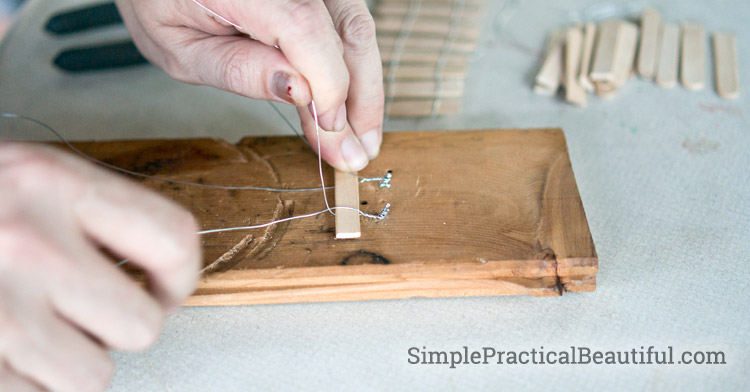
Maintaining Your Fairy Garden
Once your fairy garden is complete, proper maintenance is essential to ensure its longevity and continued allure. Here are some key aspects to consider:
Watering and Irrigation
- Watering frequency: Fairy gardens typically require regular watering, especially during dry spells or hot summer months. Monitor the soil moisture and water as needed to keep it consistently moist, but not waterlogged.
- Watering techniques: Use a watering can with a fine spout or a misting spray bottle to gently water the plants in your fairy garden. Avoid using heavy streams of water that may disturb the delicate plants or wash away the soil and decorations.
- Irrigation systems: Consider installing a micro-irrigation system with drip emitters or misters in your fairy garden for automated and efficient watering. This is particularly useful if you have a large or intricate fairy garden setup.
Weeding and Pruning
- Regular weeding: Ensure a weed-free fairy garden environment by regularly inspecting and removing any unwanted plants that may compete with your desired plants or overshadow the fairy accessories.
- Pruning and deadheading: Trim back overgrown or straggly plants to maintain their shape and appearance. Remove spent flowers to encourage new blooms and keep the garden looking tidy.
Pest Control
- Natural pest control methods: Identify and address common garden pests that may target your fairy garden plants, such as aphids, snails, or slugs. Use organic pest control methods like handpicking, introducing beneficial insects, or using natural repellents.
By incorporating these maintenance practices into your routine, you can ensure that your fairy garden remains enchanting and flourishing for a long time.
Dealing with Common Challenges in Fairy Gardens
While creating a fairy garden is a delightful endeavor, it can come with certain challenges. Here are some common issues that you may encounter and how to overcome them:
Dealing with Excessive Sunlight or Shade
- Excessive sunlight: If your fairy garden receives too much direct sunlight, consider providing shade with small umbrellas, miniature parasols, or creative plant placements. Move potted plants to shaded areas or install a shade cloth to filter the sunlight.
- Limited sunlight: If your fairy garden is situated in a shady spot, choose plants that thrive in low-light conditions, such as ferns or hostas. Alternatively, consider using artificial lighting to provide the necessary light for the plants to grow.
Preventing Soil Erosion around the Fence
- Mulching: Apply a layer of mulch around the base of your plants and along the fence to prevent soil erosion. Mulch not only helps retain moisture but also adds a decorative element to your fairy garden.
- Terracing: If your fairy garden is situated on a slope, create terraces using small retaining walls or rocks to prevent soil erosion. This helps create level surfaces for planting and adds texture to your garden.
Protecting Your Fairy Garden from Wildlife
- Fencing: Install a small mesh or wire fence around your fairy garden to keep out larger animals, such as rabbits or squirrels. Ensure that the fence is buried partly underground to discourage digging.
- Natural deterrents: Use natural deterrents like strong-smelling plants, citrus peels, or predator urine to deter smaller animals or insects from disturbing your fairy garden. These can help repel pests without causing harm to them.
By being proactive and addressing these challenges, you can maintain a beautiful and thriving fairy garden.
How to Change the Look of Your Fairy Garden
If you find that you want to refresh or update your fairy garden, there are several ways to change its look. Consider the following options:
Seasonal Changes in Fairy Garden Decor
- Spring makeover: Incorporate vibrant and colorful flowers, miniature garden tools, and tiny vegetable patches to evoke the freshness and renewal of spring.
- Summer retreat: Add miniature beach chairs, umbrellas, and seashells to create a summer vacation vibe in your fairy garden. You can even include a miniature pool or a tiny sandcastle.
- Fall splendor: Decorate your fairy garden with miniature pumpkins, scarecrows, and colorful autumn leaves to embrace the beauty of the fall season.
- Winter wonderland: Transform your fairy garden into a winter wonderland by adding tiny snow-covered trees, miniature ice skating rinks, and fairy-sized snowmen.
Rearranging Fairy Accessories and Plants
- Switch up the layout: Rearrange the fairy accessories and plants in your garden to create a new visual composition. Move the fairy houses to different areas, switch the placement of furniture, or reposition the decorative elements.
- Introduce new elements: Add new fairy figurines, miniature structures, or themed accessories to give your fairy garden a fresh look. Explore different colors, styles, or materials to expand the enchantment.
- Swap out plants: Replace some of the existing plants with different varieties or colors. Experiment with plants that bloom during different seasons to provide year-round interest.
Changing the look of your fairy garden allows you to infuse new energy and creativity into the space, providing endless opportunities for reinvention.
Inviting Wildlife to Your Fairy Garden
Creating a fairy garden not only invites the magical realm but also provides an opportunity to attract real-life wildlife. Here are some ways to welcome creatures to your garden:
Attracting Butterflies to Your Fairy Garden
- Nectar plants: Incorporate flowering plants that attract butterflies, such as milkweed, asters, or butterfly bushes. These plants provide nectar and act as a food source.
- Host plants: Include host plants where butterflies can lay their eggs and caterpillars can feed, such as parsley, dill, or fennel. This encourages the complete life cycle of butterflies in your fairy garden.
- Water source: Supply a shallow dish or saucer with fresh water for butterflies to drink and stay hydrated. Add some small rocks or sand for perching.
Providing Shelter for Birds and Bees
- Birdhouses: Install birdhouses or nesting boxes near your fairy garden to provide shelter and nesting opportunities for birds. Different bird species have specific requirements, so research the appropriate design and placement.
- Bee-friendly plants: Include flowering plants that attract bees, such as lavender, sunflowers, or salvia. These plants provide nectar and pollen, supporting the local bee population.
- Water features: Add a shallow bird bath or a small water source with rocks for perching. This allows birds to bathe and drink safely within your fairy garden.
By creating a welcoming environment for wildlife, you add an additional layer of enchantment to your fairy garden and help support biodiversity.
Creating a Miniature Water Feature in Your Fairy Garden
Adding a miniature water feature to your fairy garden can create a tranquil and captivating ambiance. Follow these steps to create a miniature pond in your fairy garden:
- Choose a container: Select a shallow container or basin that will act as your pond. Ensure it is watertight and made from a suitable material like plastic or ceramic. Size and shape depend on your available space and design preferences.
- Dig the hole: Dig a hole in the ground that matches the shape and size of your pond container. Ensure the edges are level and stable.
- Install the pond: Place the pond container into the hole, ensuring it sits level with the ground. Make any necessary adjustments to achieve a balanced appearance.
- Decorate the pond: Fill the pond with clean water, leaving a small margin at the top to prevent overflow. Add decorative elements like miniature lily pads, floating flowers, or tiny fish figurines.
- Surround the pond: Enhance the visual appeal of your miniature water feature by adding small rocks, pebbles, or tiny aquatic plants around the edges of the pond.
- Consider water movement: Incorporate a small water pump or fountain if you desire movement in your miniature pond. This creates a soothing sound and adds an extra dynamic feature to your fairy garden.
Remember to maintain the cleanliness and water quality of your miniature pond to ensure the well-being of your fairy garden inhabitants.
Fairy Garden Ideas for Different Fence Types
The type of fence can greatly influence the overall look and feel of your fairy garden. Here are some fairy garden ideas for different fence types:
Wooden Fence Fairy Garden Inspiration
- Enchanted forest: Pair a rustic wooden fence with moss-covered stones and ferns to create a magical and mysterious woodland fairy garden.
- Secret garden: Enclose your fairy garden with a wooden picket fence and surround it with climbing roses, ivy, and fragrant herbs. Add a small wooden gate to complete the secret garden vibe.
- Fairy cottage: Attach miniature fairy doors or windows to a wooden fence to mimic tiny entrances to whimsical cottages. Add miniature potted plants along the fence to create a lush and inviting boundary.
Metal Fence Fairy Garden Inspiration
- Victorian elegance: Combine an ornate metal fence with classical elements like statues, birdbaths, and topiaries to evoke the charm and sophistication of a Victorian-era fairy garden.
- Garden party: Attach fairy lights or lanterns to a metal fence to create a whimsical atmosphere for evening garden parties. Add miniature picnic tables and chairs for the fairies to enjoy their festivities.
- Butterfly paradise: Plant vibrant flowers that attract butterflies along a metal fence to transform it into a butterfly hub. Include butterfly-themed fairy accessories, such as benches with butterfly motifs or miniature butterfly fairy figurines.
Vinyl Fence Fairy Garden Inspiration
- Modern whimsy: Pair a sleek vinyl fence with contemporary fairy accessories, such as geometric-shaped planters or minimalist fairy houses. Use clean lines and a monochromatic color scheme for a modern fairy garden aesthetic.
- Fairy wonderland: Decorate a vinyl fence with hanging planters filled with colorful flowers. Attach small shelves to display fairy figurines or tiny potted plants. Opt for bright and playful fairy accessories to create a cheerful and vibrant fairyland.
Experiment with different fence designs, colors, and materials to find the perfect fit for your fairy garden vision.
Conclusion
Creating a fairy garden with a fence is an enchanting and rewarding endeavor. From selecting the perfect location and fence type to curating plants and fairy accessories, every step allows you to indulge in your imagination and create a magical sanctuary. Whether you choose a whimsical wooden fence, an elegant metal fence, or a low-maintenance vinyl fence, the possibilities for creativity and personalization are endless. So take up your shovel, unleash your inner fairy, and embark on an unforgettable journey as you bring your fairy garden with a fence to life. Let the magic begin!
